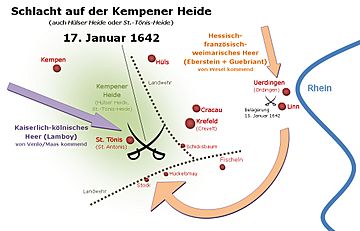Battle of Kempen facts for kids
Quick facts for kids Battle of Kempen |
|||||||
|---|---|---|---|---|---|---|---|
| Part of the Thirty Years' War | |||||||
 Battle of Kempen; engraving by Matthäus Merian |
|||||||
|
|||||||
| Belligerents | |||||||
| Commanders and leaders | |||||||
| Strength | |||||||
| 9,500 23 guns |
9,000 6 guns |
||||||
| Casualties and losses | |||||||
| 660 killed or wounded | c. 7,000 killed, wounded or captured | ||||||
The Battle of Kempen happened on January 17, 1642. It was part of the Thirty Years' War, a big conflict in Europe. The battle took place near Kempen, in what is now North Rhine-Westphalia, Germany.
A combined army from France and Hesse-Kassel fought against an army from the Holy Roman Empire. The French and Hessian forces were led by de Guébriant and von Eberstein. The Imperial army was led by General de Lamboy.
The French and Hessian forces won the battle. The Imperial army, with about 9,000 soldiers, was mostly captured or killed. This victory stopped the Imperial army's plan to invade France. It also gave France and Hesse control of the Lower Rhine area for a while.
Contents
Why the Battle of Kempen Happened
In late 1641, General de Lamboy and his Imperial army settled for winter in Kempen. Kempen was part of the Electorate of Cologne, which was an ally of Emperor Ferdinand.
Lamboy was waiting for more Imperial troops to arrive. Once combined, their plan was to invade the French region of Champagne. At the same time, the Spanish army would invade another part of France called Picardy.
Cardinal Richelieu, who was a top French leader, found out about this plan. He called Guébriant back from Northern Germany. Guébriant was given command of the French Army of Germany. This army had about 2,000 foot soldiers (infantry) and 3,500 horse soldiers (cavalry). Many of these soldiers were German mercenaries, meaning they were paid to fight.
In December 1641, Guébriant's army got stronger. Eberstein's Hessian army, with 4,000 soldiers, joined them. Armies at this time needed a lot of food and supplies for soldiers and horses. To stop Lamboy from getting supplies, the French-Hessian army crossed the Rhine river on January 11, 1642. They started to destroy the land around Lamboy's base.
On January 15, French cavalry fought off a small group of Imperial soldiers. These soldiers were checking out the area. They were led by Heinrich von Mercy, who was Lamboy's second-in-command.
The French captured some of these soldiers. They learned that another Imperial army, with 7,000 men, was near Cologne. Guébriant decided to attack Lamboy quickly, before the two Imperial armies could join together.
Lamboy's army was not fully ready. More than a third of his men were sick or didn't have weapons. He was told to avoid fighting until the other army arrived. But Lamboy ignored this advice. He set up his troops on high ground south of Kempen. He thought his position was strong enough to win.
Guébriant's army also had low supplies. He knew he had to act fast. On January 16, his troops gathered near Linn. Eberstein's men moved from Wesel to Uerdingen. To move faster, they left their heavy cannons behind.
The Battle of Kempen
The battle started with a short artillery attack from the French and Hessians. Guébriant organized his foot soldiers into three groups. These groups attacked the Imperial lines all at once. The goal was to break through and let Eberstein's horse soldiers attack from behind.
The first attack by the French and Hessians was met with strong resistance. But the French managed to capture part of the Imperial line. They brought their cannons closer and started firing at short range. At the same time, the Hessian horse soldiers defeated their opponents, who ran away.
Without the support of their horse soldiers and unable to fight back against the French cannons, the Imperial foot soldiers gave up.
About 2,000 Imperial horse soldiers managed to escape. They joined up with the other Imperial army. But the rest of Lamboy's army was mostly destroyed. About 2,000 Imperial soldiers died on the battlefield. Lamboy and Mercy were among the 4,000 to 5,000 soldiers who were captured. The French and Hessians also captured their cannons and supplies.
The French and Hessian forces had fewer losses. About 160 of their soldiers died, and 500 were wounded.
What Happened After the Battle
The destruction of Lamboy's army stopped the plan for a joint Spanish-Imperial invasion of France. The other Imperial army moved back to the city of Jülich.
The victory at Kempen allowed Guébriant to set up his base in the Electorate of Cologne. From there, he could threaten both the Spanish army and other Imperial forces.
Over the next few months, the French captured important towns in the area. These included Kempen, Neuss, and Düren. To stop the French and Hessian advance, more Imperial troops joined the fight in May. They lifted a siege at Lechenich and set up camp at Zons. The French and Hessians dug in at Uerdingen.
Because of low supplies, there wasn't much fighting during the summer. There were only small raids by horse soldiers. Even with his successes, Guébriant had to stay in the Rhineland. His army had to keep the Imperial forces busy, so they couldn't do more attacks.
Most of the captured soldiers were quickly exchanged. However, Mercy stayed captured by the French until September 1643. Lamboy was not released until six months later. Guébriant was promoted to Marshal of France after the battle. In 1643, he led his troops south and was killed during a siege in November.
Images for kids
Sources




